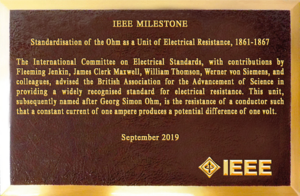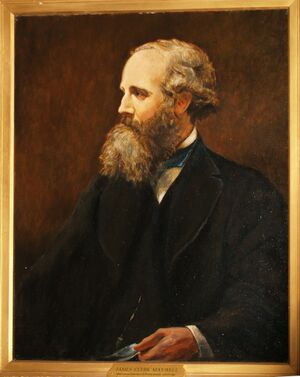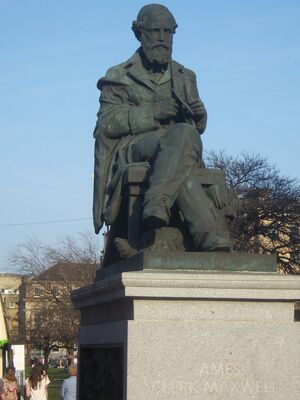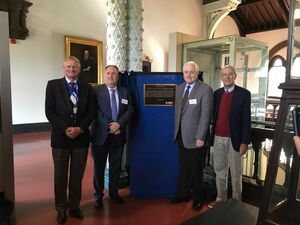Milestones:Standardisation of the Ohm, 1861-1867
- Date Dedicated
- 2019/09/17
- Dedication #
- 201
- Location
- Glasgow, Scotland
- IEEE Regions
- 8
- IEEE sections
- United Kingdom and Ireland
- Achievement date range
- 1861-1867
Title
Standardisation of the Ohm as a Unit of Electrical Resistance, 1861-1867
Citation
The International Committee on Electrical Standards, with contributions by Fleeming Jenkin, James Clerk Maxwell, William Thomson, Werner von Siemens, and colleagues, advised the British Association for the Advancement of Science in providing a widely recognised standard for electrical resistance. This unit, subsequently named after Georg Simon Ohm, is the resistance of a conductor such that a constant current of one ampere produces a potential difference of one volt.
Street address(es) and GPS coordinates of the Milestone Plaque Sites
- Site 1: Hunterian Museum, Gilbert Scott Building, University of Glasgow, University Avenue, Glasgow, Scotland G12 8QQ (GPS: 55.871807, -4.287792)
- Site 2: James Clerk Maxwell Foundation Museum, 14 India Street, Edinburgh, Scotland EH3 6EZ, (GPS: 55.955345, -3.205786)
Details of the physical location of the plaque
- Site 1: On the 2nd Floor, near the Lord Kelvin artefacts
- Site 2: Wall mounting in the museum's entrance foyer, close to a duplicate Maxwell's Equations IEEE Milestone plaque
How the plaque site is protected/secured
- Site 1: In a glass display box
- Site 2: Arrange an online or in-person visit at https://ClerkMaxwellFoundation.org
Historical significance of the work
Summary
In 1861 the British Association (BA) set up a committee [1], with Fleeming Jenkin as secretary, led by William Thomson (later Lord Kelvin) and James Clerk Maxwell, which proposed the electrical units of resistance, based on the metric system, which are still in use today. These 1865 units, specified by material standards [2], later became the International Units of 1893, which were in use until the SI units superseded them in 1948. The BA developed and fabricated in 1865 several standard resistors, which do still exist, but their stability has not withstood the passage of time.
Preamble
William Cooke (1806 – 1879) and Charles Wheatstone (1802–1875) introduced in 1839 the working telegraph. In 1850 the Anglo-French Telegraph Company laid the first undersea telegraphic cable across the English Channel. It was unsuccessful as it comprised a simple copper wire without external protection [3 p192–193]. Subsequently the next year a true cable with protected core was laid [3 p192–193] and [4]. In 1853 further successful cables linked Britain with Ireland, Belgium and the Netherlands [3 p361]. A string of failures on the second wave of cables laid in 1853-1854 led to more care being taken, both in testing the quality (resistance) of the wire and insulation and in locating faults on installed cables.
The first attempt at laying a transatlantic telegraphic cable was attempted in 1858 [5] but the cable was only in operation for one month. Subsequent attempts in 1865 and 1866 used a more advanced technology and produced the first successful transatlantic cable laying. William Thomson (1824 – 1907) [Later Lord Kelvin] sailed on the cable-laying expeditions of 1865 and 1866 which were publicly recognized as a triumph with the other principals of the project, being knighted in November 1866. To further exploit his inventions for signalling on long submarine cables, Thomson subsequently entered into a partnership with Cromwell Varley (1828 – 1883) and Fleeming Jenkin (1833–1885), the later from Newall’s Liverpool cable factory. Varley was an astute businessman and the partnership that he formed with Thomson and Jenkin, to exploit their respective telegraphic inventions, yielded them significant personal profits. Jenkin was for several years the engineer in charge of international cable laying operations before becoming Regius Professor of Engineering at The University of Edinburgh in 1868. Prior to 1860 there was no widely-accepted system of electrical units or standards.
Electrical Resistance
The above rapid rise of electrotechnology created a demand for a rational, coherent, consistent, and international system of units for electrical quantities. The telegraphers and other early users of electricity needed a practical standard unit of measurement for resistance. Resistance was often expressed as a multiple of the resistance of a standard length of telegraph wire and units were not readily interchangeable. Electrical units so defined were thus not a system which was coherent with the units for energy, mass, length, and time, requiring conversion factors to be used in calculations relating energy or power to resistance [1]. In the 1850’s, Michael Faraday (1791 – 1867) and William Thomson demonstrated how the core resistance of a transatlantic cable could limit messages to only one character every four seconds! It was therefore important to know precisely the quality of the conductor, i.e. the resistance.
Resistance coils, calibrated in feet of copper wire or similar small units, had been introduced for laboratory use in the 1840s by Charles Wheatstone (1802–1875), M H Jacobi, and others. Wheatstone had proposed a foot of copper wire weighing 100 grains in 1843, and Jacobi had sent copies of a longer "etalon" to various physicists in 1848 [1], but neither of these standards were widely adopted. These material standards were calibrated as miles of copper wire in the UK, km of iron wire in France and miles of iron wire in Germany [1]. An alternative to these arbitrary material standards of resistance had existed, at least on paper, in the "absolute" system based on units of force and motion that Wilhelm Weber (1804–1891), building on Gauss's earlier magnetic work, had published in 1851 [1]. Rather than simply defining a certain piece of wire as the unit of resistance, the absolute system required a delicate measurement, with special apparatus, to determine the resistance of a given wire in terms of a velocity [1].
In 1860 Werner von Siemens (1816–1892) published a suggestion for a reproducible resistance artifact standard based on a column of pure mercury [5], of one square millimeter cross section, one meter long. This Siemens mercury based unit was somewhat larger and thus not coherent with the wire related units. Charles Bright (1832–1888) and other engineers suggested the adoption of larger units, more in keeping with Siemens unit. Jenkin later noted, "the first effect of the commercial use of resistance was to turn the 'feet' of the laboratory into 'miles' of telegraph wire," and Bright's coils were indeed calibrated in equivalents of a mile of wire. The replication and refinement of such resistance coils in the 1850s and 1860s was thus crucial to the spread of precision electrical measurement among both engineers and physicists.
In 1861, Latimer Clark (1822–1898) and Charles Bright presented a paper [7] at the British Association for the Advancement of Science (BAAS) meeting suggesting that standards for electrical units be established and they suggested names for these units derived from eminent philosophers, 'Ohma', 'Farad' and 'Volt'. The BAAS in 1861 responded by appointing, on William Thomson’s suggestion, the British Association Committee on Electrical Standards, with Fleeming Jenkin, acting as secretary. This committee included James Clerk Maxwell (1831-1879) and Thomson and it was tasked to report upon and define Standards of Electrical Resistance [8, 9].
The committee objectives were to devise a unit that was of convenient size, part of a complete system for electrical measurements, coherent with the units for energy, stable, reproducible and based on the French metrical system [8, 10]. The committee thus rapidly identified in 1862 the difference between and requirement for both 'units' and 'standards' for resistance. This committee was driven by Thomson, Maxwell and Jenkin prior engineering cable laying experiences as they wished to select units whose magnitudes would suit the needs of the telegraph engineers.
The committee thus created the “BA unit” of resistance, an absolute unit based on a meter-gram-second (mgs) system of units. However, on working out the size of the mgs unit of resistance they found it would be much too small for the needs of the telegraph engineers. Thus they recommended a practical unit of resistance to be 107 times larger than the mgs absolute unit of resistance. In one sense the choice of 107 was arbitrary, except that it made, for example, a mile of the usual size of telegraph wire have a resistance of 10 ohms in today’s notation.
The “BA unit of resistance” was thus selected to be equivalent to 10 million meters per second, making it just a few percent larger than Siemens's mercury unit [5], and so of much more convenient size for cable use. The committee encountered problems when performing absolute measurements of the required precision which meant it was late 1863 before they could offer even a tentative resistance standard. In the 1864 third report of the committee the resistance unit is referred to as "BA unit or Ohmad" [8, 11]. Their early standard resistance coils consist of loosely wound wire mounted in annular copper cans which were then filled with paraffin wax, see below, with Jenkin requesting that they be deposited a “public institution” [1], similar to the standard yard located in London. These coils were prepared for measurement of the “BA unit” and after many painstaking measurements by Jenkin, Maxwell, the Scottish physicist Balfour Stewart (1828 – 1887), etc, the committee finally issued its official resistance standards in February 1865.
By 1865 they claimed to have ten resistors all adjusted as closely as possible to 107 m/s, with several copies of these standards. The BA Committee had decided [8 p47] to adopt “one particular standard, constructed of very permanent materials and laid up in a national repository”, and that it should be a coil of wire having a resistance adjusted as nearly as possible to 107 m/s. In 1863 and 1864 Maxwell and Jenkin measured the resistance of two particular coils [8 p158, p167 and p197] which were later used to establish the 1 ohm standard. In a brief note in the Philosophical Magazine, Jenkin, as secretary of the committee, announced that copies of the standard resistance were now available, and that "A unit coil and box will be sent on receipt of the remittance of £2 10s" [13]. These standard resistors were located in the Kew observatory, Cavendish Laboratory, etc., before transfer, in 1955, to the Science Museum.
The actual instrument proposed by Thomson to define the BA unit alongside Maxwell, see photo of the portrait in the attached file, employed a magnet suspended within a spinning coil of standard wire. Jenkin rotated the coil and Maxwell took the measurements as they led the experimental verification of the coil resistance. The text in [15] does confirm that the revolving-coil apparatus shown on the table in the portrait of Maxwell was that designed by Lord Kelvin and was the one actually used in 1863 to first determine the value of the ohm. Their reports, published along with others including those of Wheatstone and Siemens, culminated in 1867 in the adoption of the unit that we now represent with the symbol Ω [12]. Later, in 1872, the committee recommended a change to the name from “BA unit of resistance” to the "ohm," naming it after the German physicist and mathematician Georg Ohm (1789 – 1854).
Subsequent developments
In 1881 a practical Ohmic unit, based on centimeter-gram-second (cgs) units, used a mercury column, similar to that of Siemens. A legal ohm standard, was then proposed in 1884 as a compromise value between the BA unit, the Siemens unit, and the above cgs unit, but this was never adopted by a national legislation. This represented an intermediate stage of approximation to the present day international unit values. The "international" ohm was recommended later in 1893 [14] and became the basis for the legal definition of the ohm in several countries, with further adoption in 1908 [14]. In 1948 the ohm was redefined in absolute terms instead of as an artifact standard.
The ohm is defined as an electrical resistance between two points of a conductor when a constant potential difference of one volt, applied to these points, produces in the conductor a current of one ampere. Today, the definition of the ohm is expressed from the quantum Hall effect. The siemens (S) is the SI derived unit of electric conductance and admittance, is the reciprocal of resistance in ohms (Ω).
Further evidence of the collaborations on resistance measurement, shown in an attached file, with a 1871 letter from Maxwell to Siemens. In 1873, both Maxwell and Jenkin each published their individual textbooks on electricity and magnetism.
http://ethw.org/System_of_Measurement_Units#Evolution_of_Electromagnetic_System_of_Units already provides a summary of this technological development.
Features that set this work apart from similar achievements
This the first formal definition of the Ohm as a resistance standard.
Significant references
Copies of the following supporting articles are on file at the IEEE History Center for the use of the milestone advocate. Because they are copyrighted, they cannot be posted on the ETHW or shared.
[1] Hunt, Bruce J (1994). "The Ohm Is Where the Art Is: British Telegraph Engineers and the Development of Electrical Standards" (PDF). Osiris. 2nd. 9: 48–63. doi:10.1086/368729. PDF supplied
[2] A.C. Lynch, “History of the electrical units and early standards”, IEE PROCEEDINGS, Vol. 132, Pt. A, No. 8, pp. 564-572, DECEMBER 1985 PDF supplied
[3] Haigh, Kenneth Richardson (1968). Cable Ships and Submarine Cables. London: Adlard Coles. ISBN 9780229973637.
[4] Brett, John Watkins (March 18, 1857). "On the Submarine Telegraph". Royal Institution of Great Britain: Proceedings (transcript). II, 1854–1858.
[5] Guarnieri, M. (2014). "The Conquest of the Atlantic". IEEE Industrial Electronics Magazine. 8 (1): 53–56/67. doi:10.1109/MIE.2014.2299492.
[6] Werner Siemens (1860), "Vorschlag eines reproducirbaren Widerstandsmaaßes", Annalen der Physik und Chemie (in German), 186 (5), pp. 1-20, Bibcode:1860AnP...186....1S, doi:10.1002/andp.18601860502
[7] Clark, Latimer; Bright, Sir Charles (1861-11-09). "Measurement of Electrical Quantities and Resistance". The Electrician. 1 (1): 3–4. Or CLARK, L., and BRIGHT, Sir C.: 'On the formation of standards of electrical quantity and resistance', BA Annual Report, 1862 (reporting the 1861 meeting), Trans, of Sections, pp. 37-38
[8] 'Reports of the [BA] Committee on electrical standards' (Cambridge, 1913) or as below for specific events:
[9] Report of the Thirty-First Meeting of the British Association for the Advancement of Science; held at Manchester in September 1861. September 1861. pp. xxxix–xl.
[10] Williamson, Professor A; Wheatstone, Professor C; Thomson, Professor W; Miller, Professor WH; Matthiessen, Dr. A; Jenkin, Mr. Fleeming (September 1862). Provisional Report of the Committee appointed by the British Association on Standards of Electrical Resistance. Thirty-second Meeting of the British Association for the Advancement of Science. London: John Murray. pp. 125–163.
[11] Williamson, Professor A; Wheatstone, Professor C; Thomson, Professor W; Miller, Professor WH; Matthiessen, Dr. A; Jenkin, Mr. Fleeming; Bright, Sir Charles; Maxwell, Professor; Siemens, Mr. CW; Stewart, Mr. Balfour; Joule, Dr.; Varley, Mr. CF (September 1864). Report of the Committee on Standards of Electrical Resistance. Thirty-fourth Meeting of the British Association for the Advancement of Science. London: John Murray. p. Foldout facing page 349.
[12] Williamson, Professor A; Wheatstone, Professor C; Thomson, Professor W; Miller, Professor WH; Matthiessen, Dr. A; Jenkin, Mr. Fleeming; Bright, Sir Charles; Maxwell, Professor; Siemens, Mr. CW; Stewart, Mr. Balfour; Varley, Mr. CF; Foster, Professor GC; Clark, Mr. Latimer; Forbes, Mr. D.; Hockin, Mr. Charles; Joule, Dr. (September 1867). Report of the Committee on Standards of Electrical Resistance. Thirty-seventh Meeting of the British Association for the Advancement of Science. London: John Murray. p. 488.
[13] Fleeming Jenkin, "Electrical Standard" (letter to the editor, 7 Feb. 1865), Phil. Mag., March 1865, 29:248.
[14] "Units, Physical". Encyclopædia Britannica. 27 (11th ed.). 1911. p. 742.
[15] Proceedings of the IEE, vol.68, issue 397, January 1930, pp. 198-201. (Start at bottom of page 199 for Atkinson’s speech) pdf supplied
[16] Grant, Peter M.; Thompson, John S. (November 2019). "Standardization of the Ohm as a Unit of Electrical Resistance, 1861-1867". Proceedings of the IEEE (Vol. 107, Issue 11), pp. 2281-2289.
Supporting materials
- UK&I Section Story: Standardisation of the Ohm Milestone Dedication
- James Clerk Maxwell Foundation document: Transatlantic Cables and the Ohm
Dedication Ceremony
Map











